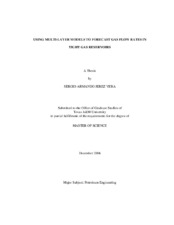| dc.description.abstract | The petroleum industry commonly uses single-layer models to characterize and forecast long-term production in tight gas reservoir systems. However, most tight gas reservoirs are layered systems where the permeability and porosity of each layer can vary significantly, often over several orders of magnitude. In addition, the drainage areas of each of the layers can be substantially different. Due to the complexity of such reservoirs, the analysis of pressure and production history using single-layer analyses techniques provide incorrect estimates of permeability, fracture conductivity, drainage area, and fracture half-length. These erroneous values of reservoir properties also provide the reservoir engineer with misleading values of forecasted gas recovery. The main objectives of this research project are: (1) to demonstrate the typical errors that can occur in reservoir properties when single-layer modeling methods are used to history match production data from typical layered tight gas reservoirs, and (2) to use the single-layer match to demonstrate the error that can occur when forecasting long-term gas production for such complex gas reservoirs. A finite-difference reservoir simulator was used to simulate gas production from various layered tight gas reservoirs. These synthetic production data were analyzed using single-layer models to determine reservoir properties. The estimated reservoir properties obtained from the history matches were then used to forecast ten years of cumulative gas production and to find the accuracy of gas reserves estimated for tight gas reservoirs when a single-layer model is used for the analysis. Based on the results obtained in this work, I conclude that the accuracy in reservoir properties and future gas flow rates in layered tight gas reservoirs when analyzed using a single-layer model is a function of the degree of variability in permeability within the layers and the availability of production data to be analyzed. In cases where there is an idea that the reservoir presents a large variability in ‘’kâ€Â, using a multi-layer model to analyze the production data will provide the reservoir engineer with more accurate estimates of long-term production recovery and reservoir properties. | en |


